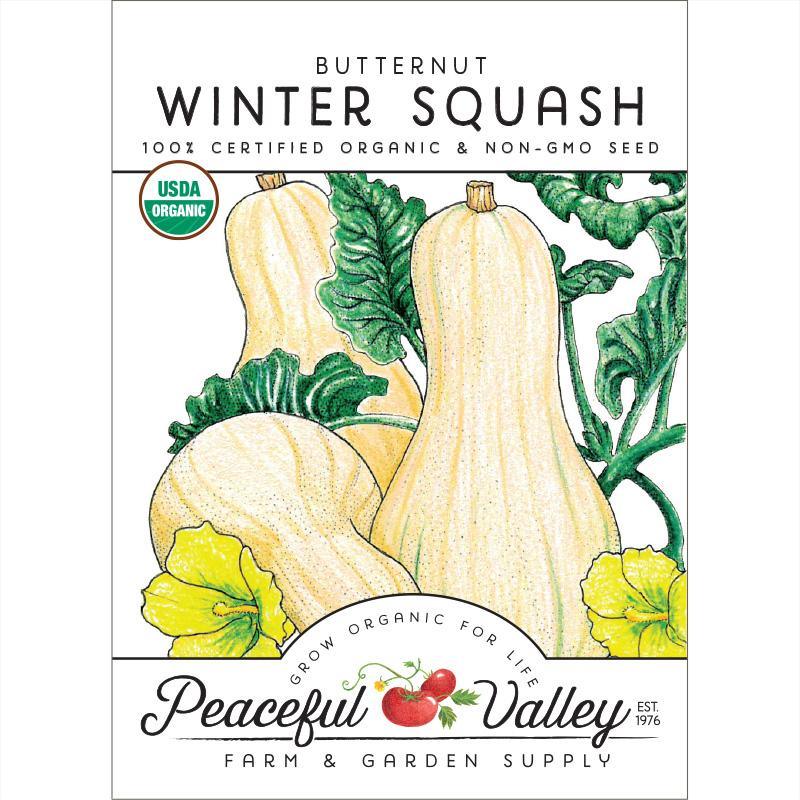Item Number: SNV8156
Butternut Winter Squash Seeds (Organic)
Sweet flavor, creamy texture.
- Growing Zones: Adaptable to various zones, generally USDA zones 3-11.
- Chill Requirements: Typically doesn’t require specific chill hours for fruiting.
- Bloom Time: Late spring to early summer.
- Harvesting Dates: Harvest in late summer to fall when the squash has matured and the skin has hardened.
- Looks: Butternut squash has a creamy-tan outer skin and a bulbous base that tapers to a narrower neck.
- Personality: Known for its sweet and nutty flavor, it's versatile in culinary use and stores well.
- Facts of Note: Rich in vitamins, minerals, and antioxidants. High in vitamin A, C, and potassium.
- Pollinator: Winter butternut squash plants have separate male and female flowers; while they don't require a separate pollinator, bees or other pollinators aid in fruit development.
- Ideal Soil Temperatures: Soil temperatures around 70°F (21°C) promote good growth.
- Planting Depths: Plant seeds about 1 inch deep in mounds or rows.
- Germination Periods: Seeds germinate in 5-10 days under optimal conditions.
- Height at Maturity: Vines can spread up to 10-15 feet.
- Days to Maturity: Approximately 75-100 days from planting to harvest.
- Sun/ Shade: Butternut squash thrives in full sun, requiring at least 6-8 hours of direct sunlight daily.
- Spacing After Thinning: Plant seeds or seedlings 18-24 inches apart to allow ample space for vine growth.Butternut Squash
- Approx Seeds per Pack: 25 | Per 1/4 lb bulk: 1,088 Seeds
Growing Butternut Winter Squash seeds can be a rewarding venture, offering delightful, sweet-flavored squash for hearty soups or pies. Understanding the cultivation process from planting to harvest ensures a successful yield in your home garden.
Understanding Butternut Winter Squash:
Squash Variety: Butternut Winter Squash (Cucurbita moschata) thrives in northern regions, producing uniform, buff-colored fruit with dry, fine-grained flesh and a sweet squash flavor.
Nutritional Value: Rich in beta-carotene, potassium, niacin, and iron, winter squash offers a nutritional boost in culinary endeavors.
Planting Butternut Squash Seeds:
Soil Preparation: Create deep mounds of organic-rich soil, ensuring even moisture retention. Mulching aids in heating soils early in spring and protects against frost.
Planting Depth and Timing: Start seeds indoors 3-4 weeks pre-frost or sow directly once soil temperatures reach 70°F.
Caring for Butternut Squash:
Watering Requirements: Provide consistent and even watering, aiming for about an inch of water per week to keep the soil moist but not waterlogged.
Frost Protection: Shield plants from the danger of frost using row covers, especially crucial in shorter growing seasons.
Growing and Harvesting:
Maturation Period: Butternut squash matures within 75-110 days, developing a shriveled stem or tough skin as indicators for harvest readiness.
Harvesting Technique: Cut squash leaving 2"-3" of stem, cure them in the sun for ten days to toughen the skin, and store in cool, dry conditions.
Optimizing Growth Conditions:
Sun Exposure: Provide full sun exposure to foster healthy growth and fruit development.
Spacing Consideration: Allow ample space of at least 18" between plants after thinning for robust vine expansion.
Growing Butternut Winter Squash seeds involves meticulous care from planting through harvest. Protecting against frost, ensuring proper moisture levels, and harvesting at the right stage contribute to a plentiful yield of flavorful squash, perfect for your favorite dishes.
Check out our other seed collections here: Seed pack and bulk seed collections
We have other growing supplies you may need here: Growing Supplies




Check Your Zone Compatibility:
Compatible with your zone.
Growing Zone for

Our Guarantee To You
Since 1976, we've served our customers at every stage of growing. Please contact us at any time. We are happy to support and assist you.
Shipping Information
Shipping Information
Shipping Weight: 0.01 lb
Dimensions: 4.5"L x 3.25"W x 0.1"H
Features
Features
- Open-Pollinated
Characteristics
Characteristics
Planting & Care
Planting & Care
Soil & Water: Provide squash plants with deep mounds of organic matter, rich soil, and heavy, even water. All squash are extremely frost sensitive, so use mulch to heat soils in early spring and row covers to protect from frost at both ends of the growing cycle, especially in short growing seasons.
Planting & Growing: Start seeds indoors 3-4 weeks before the last frost, or sow seed directly once soils are at least 70°F.
Harvesting & Storage: Harvest when stems begin to shrivel or you can no longer pierce the skin with a thumbnail, but be sure to harvest before the first hard frost. Cut squash from the vine leaving 2"-3" of stem attached. Allow to cure in the sun for 10 days to finish hardening the skins. Store in cool, dry conditions.
Useful Information
Useful Information
Guarantee
Guarantee

Peaceful Valley Farm & Garden Supply brand vegetable seeds are guaranteed to germinate. Once the seeds have sprouted, please understand that Peaceful Valley cannot be held responsible for the many uncontrollable growing and climatic conditions that must be met to ensure the success of your crop(s).
Share




